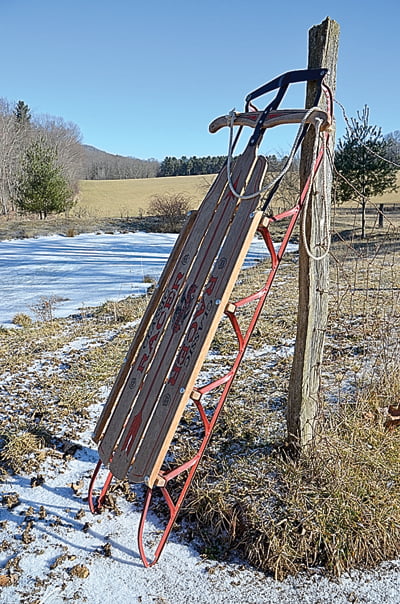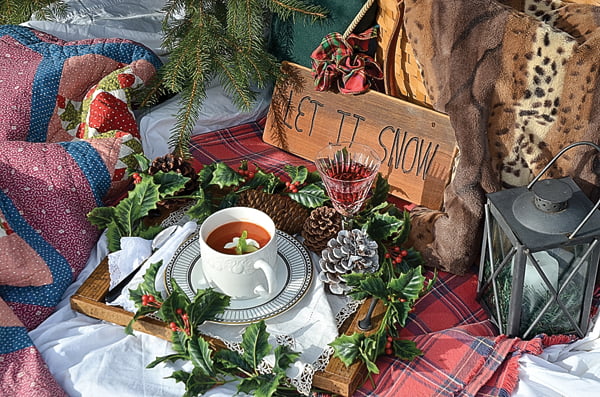
For people of a certain age, winter memories include snowball fights, building snowmen and Flexible Flyer sleds. Kids these days may be using plastic discs to slide down snowy hillsides, but nothing can top the timeless elegance of a Flexible Flyer Classic Racer. These beauties are still selling. Their simple design is so functional that modern technology has no need to improve it. Sleds should always be waxed up and waiting for the next generation.
Laura Dean Bennett
Staff Writer
Sleds are primarily thought of as recreational in modern America, but they began as one of mankind’s earliest modes of transportation.
Since before recorded history, in areas of the world covered by snow in winter, man found that transporting people or materials in snowy or icy conditions was far easier via sled than by wheeled conveyance.
Whereas a cart is dependent upon its wheels and the existence of a road, a sled pulled by hand or by a draft animal, could glide across ice and snow relatively easy.
The word, sled, comes from the Middle English word “sledde,” meaning “slider.”
The earliest examples were hand-pulled, but many cultures used domestic animals – dogs, horses or oxen – to pull sleds, sledges and sleighs.
For millennia, humans moved heavy objects, people and goods overland – whether covered by snow, sand or grass – by sledges and sleighs.
The earliest evidence of tobogganing may be a story from the Cimbric War, fought between Rome and the Germanic tribes in the second century A.D.
The Cimbri caught the Romans by surprise after they successfully crossed the Alps into Northern Italy using their shields as sleds.
The huge stone blocks of the Egyptian pyramids and the towering Easter Island statues are thought to have been drawn into place with sledges, and the materials for the great stone cathedrals of Medieval Europe were assembled with their help.
Russian merchants in the 17th and 19th centuries were known to prefer moving goods and cargo in winter rather than having carts and wagons bogging down in mud in “better” weather.
Sleighs took the Arctic and Antarctic explorers across the icy expanses of the North and South Poles and continue to do so.
These days, giant machines called Snow Cats may have replaced dog sleds for packing people, equipment and supplies in and out of remote frozen locations, but there are still many Inuit people using huskies to pull sleighs.
When people could afford to take time away from the work of survival and spend energy on having fun in the snow, sleds began to be designed for recreation.
Young Russian aristocrats were among the first to discover the potential of sledding for pure fun. As early as the 1650s, they risked life and limb riding down specially constructed wooden tracks in sleds carved from blocks of ice.
There were toboggans – long sleds without runners, which were originally made of wood and capable of carrying more than one rider.
Bobsleds, luges and skeletons were crafted with speed and competitive sports in mind – just like we see in the Winter Olympics.
It’s hard to imagine a time when a big snowfall will not tempt children of all ages to head outside to slide down a hill on sleds.
Our love of sledding is epitomized in Orson Welles’s 1941 masterpiece, “Citizen Kane.”
In it, “Rosebud,” is a wooden sled that symbolizes the American way of life.
And in another quintessential American film, Frank Capra’s 1946 classic, “It’s a Wonderful Life,” there is a joyful scene of children sledding on a wintry day.
My personal experience of sleds is confined to the old Flexible Flyer “Classic Racer” that my mom and dad gave me when I was a little girl.
These days, kids may be schussing down icy slopes on plastic discs and on inner tubes, but for people of my generation, our winter memories include snow days, snowball fights, building snowmen, wet mittens and, of course, our trusty Flexible Flyers.
And we have a Pennsylvania Quaker farmer named Samuel Leeds Allen – a prolific inventor who held nearly 300 patents – to thank for one of America’s most beloved sleds.
He worked with his father, John Allen, in the barn on their farm, Ivystone.
Their company manufactured farm equipment, and the younger Allen decided to build sleds to diversify their product line.
Allen made the first Flexible Flyer sled in 1860, patented the design in 1889 and immediately, the new steerable sleds were the darlings of sledding enthusiasts, who had heretofore been making do with toboggans and goose-necked sleds.
As many Currier & Ives winter scenes attest, sleigh rides and sledding, or “coasting,” were very popular winter pastimes in the 1800s.
Samuel Allen’s inspiration for the Flexible Flyer came from the sledding he’d done at his boarding school. As he was trying out designs for the sled, his own children happily served as testers for each variation.
His introduction of “The Sled That Steers” – the Flexible Flyer Classic Racer – ushered in the modern age of sledding.
It boasted a patented “floating crossbar” steering head that had rolled edges situated over the center rivet and allowed for a certain degree of steering freedom.
The wooden steering arms of the Classic Racer were jigsaw-cut and had curved and sanded edges and the deck carried a silk-screened logo and pin striping on its three wooden panels.
Underneath were high-strength steel runners which would be kept waxed by the sled’s owner to decrease resistance and increase speed.
Company records show that in 1915, 120,000 Flexible Flyers were sold by the Pennsylvania company – an average of about 328 per day.
They varied in size and price – from the smallest children’s sled, which sold for $2.50, to the largest, the 8.5 feet long, 41 pounder, designed to hold up to six adults, which cost $12.
In 1928, six Flexible Flyers accompanied Admiral Richard E. Byrd to the South Pole.
The Flexible Flyer design was so simple and functional that modern technology has been able to add little to it. And that is why the Flexible Flyer has changed very little since it’s inception in the Victorian era.
Foreign competition and the use of plastics in the sled market eventually spelled a temporary doom for for the Allen Company and the Flexible Flyer name passed through a series of owners in the 1970s and 1990s.
But in 2005, a Maine company called Paricon— in business since 1861, making a sled called the Speedaway— purchased the rights to the Flexible Flyer name.
And the Flexible Flyer Classic Racer is still selling.
Paricon managing director Tom Morton is a fifth generation sled maker who says his company’s Flexible Flyer is “as close as you can come to the original. They’re made the same way, and we still use the same wood – North American birch.”
But who in the 21st century is willing to pay close to a hundred dollars for a wood-and steel American classic?
Apparently, baby boomers are.
“It’s usually parents and grandparents, folks who want their kids and grandkids to have the same experience they did as kids,” Morton explained.
I can confirm how nostalgic we can be about our old sleds.
Even now my old Flexible Flyer Classic Racer is leaning up against the garage wall, waiting for a snowy day and, eventually, perhaps, to be a valued inheritance.



